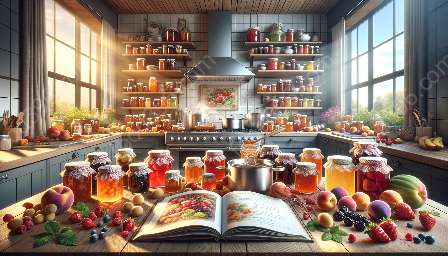Is there anything better than a dollop of flavorful jam or jelly on your morning toast or scone? However, with wellness concerns on the rise, many people are seeking healthier alternatives to traditional high-sugar spreads. This has prompted interest in low sugar or sugar-free jams and jellies, which provide the sweetness and flavor of traditional preserves without the high sugar content.
For those interested in delving into the art of jam and jelly making while mastering food preservation and processing, it's important to understand the techniques and methods for creating delicious low sugar or sugar-free options. In this comprehensive guide, we'll explore various approaches to making these healthier alternatives, ensuring you can enjoy the delightful experience of homemade jams and jellies while adhering to your dietary goals.
Understanding the Basics
Before delving into the specific techniques for making low sugar or sugar-free jams and jellies, it's essential to understand the foundational principles of jam and jelly making, as well as the necessary food preservation and processing methods. This knowledge forms the groundwork for successfully creating these delightful spreads.
Jam and Jelly Making
Jam and jelly making involves the combination of fruit, sugar, and pectin, a natural substance that helps the mixture thicken. Traditionally, jam contains both fruit pulp and pieces, while jelly is made from fruit juice alone, creating a clear, gelled product.
Food Preservation and Processing
Food preservation and processing are crucial aspects of jam and jelly making. Techniques such as sterilizing jars, creating proper seals, and utilizing the appropriate canning methods ensure the longevity and safety of the preserves. Additionally, understanding the roles of sugar and pectin in preservation is key to successful low sugar or sugar-free recipes.
Techniques for Low Sugar or Sugar-Free Jams and Jellies
Now, let's explore the various techniques for making low sugar or sugar-free jams and jellies, providing both health-conscious options and the satisfaction of skilled culinary craftsmanship.
Fruit Selection
The foundation of any jam or jelly is, of course, the fruit. When aiming for low sugar or sugar-free recipes, selecting naturally sweet fruits can help minimize the need for additional sweeteners. Berries, peaches, and apricots are excellent choices due to their natural sweetness and high pectin content, which contributes to the jam's thickening process.
Natural Sweeteners
One of the primary techniques for reducing sugar in jams and jellies involves the use of natural sweeteners, such as stevia, monk fruit, or erythritol. These alternatives provide the desired sweetness without the high sugar content, allowing for guilt-free indulgence.
Pectin-Free Recipes
For those who prefer to avoid pectin, creating jams and jellies without this ingredient is a viable option. Using high-pectin fruits, simmering the mixture to reduce liquid content, and employing additional natural thickening agents, such as chia seeds or gelatin, can yield successful results.
Reducing Sugar Gradually
If you're accustomed to traditional jam and jelly recipes but want to lessen the sugar content, consider gradually reducing the amount of sugar in your recipes. By minimizing the sugar incrementally, you can adjust to less sweetness while still enjoying the delightful flavors of your homemade preserves.
Embracing Flavorful Additions
An effective method of enhancing low sugar or sugar-free jams and jellies is through the addition of flavorful ingredients. Citrus zest, spices, and vanilla extract can elevate the taste profile, compensating for the reduced sugar and adding a unique and delightful twist to your preserves.
Further Considerations
Understanding Gel Points
It's essential to grasp the concept of gel points when creating low sugar or sugar-free jams and jellies. Gel points refer to the temperature at which the fruit-sugar-pectin mixture thickens sufficiently to create a spreadable consistency. Understanding and monitoring the gel point is crucial for achieving the desired texture in your preserves.
Canning and Preservation Techniques
Ensuring the longevity and safety of your low sugar or sugar-free jams and jellies involves proper canning and preservation techniques. Familiarize yourself with the principles of water bath canning and pressure canning to seal in the goodness of your homemade preserves for future enjoyment.
Conclusion
Creating low sugar or sugar-free jams and jellies is a delightful and rewarding endeavor, promising the enjoyment of luscious spreads without compromising dietary goals. By mastering the techniques for crafting these healthier alternatives and gaining an understanding of jam and jelly making alongside food preservation and processing, you can indulge in the art of preserving while embracing wellness-conscious choices. Explore the bountiful world of fruit, natural sweeteners, and culinary creativity, and savor the satisfaction of homemade low sugar or sugar-free jams and jellies.

